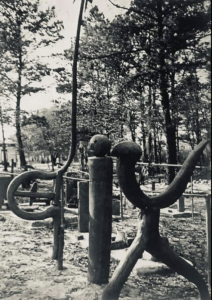In the mythology of modern art, there are a few old chestnuts that get repeated again and again. There is the time Vincent van Gogh cut off his ear and then bore witness through confessional portraiture. There is the time Pablo Picasso unveiled his first masterpiece, Les Demoiselles d’Avignon, and declared it an “exorcism.” (For Picasso, painting got your fears into the open; this launched decades of brazenly angsty art.) And there is the time that the elegant maverick Marcel Duchamp submitted a white porcelain urinal to a New York City art exhibition. He titled it Fountain. Recently it was voted the most influential artwork of the 20th century.

(https://commons.wikimedia.org/wiki/File:Duchamp_Fountaine.jpg)
Marcel Duchamp, though a skilled artist, was perhaps chiefly a master of dramatic gesture. Another Duchamp “old chestnut” concerns his famous multimedia piece The Large Glass, which still eludes satisfactory interpretation. This strange piece, consisting of two, superimposed panes of glass adorned with lead wire and brown paint, seems to tell a story of rape between machines, satirizing our modern inability to make authentic connections. But the intended meaning of The Large Glass is almost beside the point. Instead, the story everyone tells is about the cracks on its surface: cracks not made by Duchamp himself, but by hapless art handlers in 1927.

(https://en.wikipedia.org/wiki/File:Duchamp_LargeGlass.jpg)
As the story goes, while The Large Glass was in transit from the Brooklyn Museum following its debut exhibition, handlers dropped it and shattered the panels, necessitating a “sandwich-style” fix to prevent the loss of Duchamp’s design. Unfortunately, the glass was irrevocably broken, its web-like fractures impossible to obscure. The artist, however, took it in stride. In fact, he credited the handlers with “completing” his work! At a time when artists were trying to escape the bondage of stultifying reason (aren’t they always?), the art handlers’ mistake introduced an element of pure, uncontrollable serendipity. The shatter pattern was poignant, beautiful. It completed the artwork’s existentialist message of dissatisfaction with the soulless regimentation of modern life.
Duchamp was only verbalizing what artists from all times and places have tried to express through what they make. From the very beginning, human creators have welcomed the uncontrollable and unpredictable in their quests for profundity and beauty. In late medieval Belgium, wood carvers celebrated the irregular starshake patterns in cracked limewood trunks, using the fissures to create elaborate drapery designs. The centuries-old Japanese art form of kintsugi restores broken ceramics with gold, highlighting marks of “accident” with luster and shine. And the modern folk artist Cyrus Bowens relied on the strange and prodigious shapes of fallen branches to make his family’s tombstones – or rather, tombsticks.
https://commons.wikimedia.org/wiki/File:Tilman_Riemenschneider_Barbara-1.jpg (starshake)
https://journal.musubikiln.com/kintsugi-an-artform-and-a-way-of-life/ (kintsugi)
 https://m.facebook.com/groups/435350943483959/permalink/1351515571867487/ (Bowen)
https://m.facebook.com/groups/435350943483959/permalink/1351515571867487/ (Bowen)
But how often do the rest of us embrace that lack of control?
Maybe “art” is a low-stakes place to make those kinds of gestures. There are no life-or-death consequences in art, at least generally speaking. In art, embracing disruption makes you different, distinctive – and it opens avenues for creativity and new thought. In life, however, the embrace of “accident,” of the unpredictable, can seem masochistic or worse. We all – especially the more educated among us – spin out scenarios, anticipate outcomes, revel in our “farsightedness.” So many of our choices are “insurance policies” against events that we can’t control.
Nevertheless, the Bible asks us to do something like this – to say to the thing that has wounded us: “Thank you for completing the work.” When Paul hints at this in Romans chapter 8 (“we know that in all things God works for the good of those who love him”!), he is not being masochistic. Nor were the great suffering saints – from the early martyrs to Teresa of Calcutta – being self-punishing when they embraced hardship as a path to God. They spoke from a place not of harsh dogma, but of experience and gratitude. They knew in their spirits the good that shaking and shattering can do.
For many of us, in this highly medicated, scented-candled, mood-lit 21st century, our first impulse is to always escape pain, escape dissonance, escape the discomfort of lack of control. Disagreements and misfortunes are slaps in the face that we cannot abide by – that cause us to quail in our inmost hearts.
Nevertheless, in all things God works for the good! In the pain of conflict, God works for the good. In cases of disaster, God works for the good. In times of deprivation, God works for the good – weaning us from broth or baubles that don’t satisfy.
Therefore, may we be brave, like the youthful David before Goliath, taking off our armor and running to the front line. May we embrace the unpredictable, even as we lay our tender selves bare. For in God, the loss of small loves yields greater Love. The loss of wealth leads to treasure in heaven. And the loss of life leads to Life Eternal. By the grace of Jesus, may I say (and own) this: I thank you my Father for the turbulence of my times. I thank you for unexpected loss. And I thank you for threats and wounds to my fragile flesh. Through all of these you complete the work, showing your celestial beauty, and drawing me dearly, shakingly, shiningly near to your heart.


























Katie, I am a born again artist, many are. I currently, and for the past 3 years, have interacted with a brilliant artist who not only writes extremely well and who I enjoy fellowship every Saturday by email is one who has not been born again. But God is pursuing her.
Praise God for His gift to hands and hearts who use them to exalt His glory. Vernona